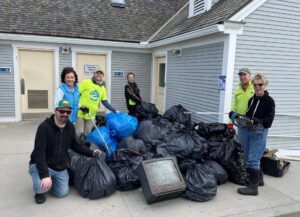 HYANNIS – You’re heading out to the beach or park on a summer’s day and the car is packed with tote bags full of items such as food, drinks, beach towels, sandals, beach toys and blankets. The bikes are on the rack and helmets are safely tucked in their spot on the floor.
HYANNIS – You’re heading out to the beach or park on a summer’s day and the car is packed with tote bags full of items such as food, drinks, beach towels, sandals, beach toys and blankets. The bikes are on the rack and helmets are safely tucked in their spot on the floor.
The kids are ready and everything you need for a summer outing is good to go…or is it?
One of the most important items that could potentially save the day in case of a scrape, cut, bee sting, insect bite or sunburn, is a first aid kit.
“The more you can be prepared for accidents and injuries, the better it is,” said Emily O’Connell, MD, a pediatrician at Falmouth Hospital.
A 2008 report by the Centers for Disease Control and Prevention (CDC) revealed that 2.8 million children were seen in hospital emergency departments from 2000-2006 and unintentional falls were the leading cause of injuries. The report listed other causes of injuries as being struck by or against an object, animal bites, bee stings and overexertion.
One of the first things to do in the event of an injury, insect bite or bee sting is to remain calm, according to Dr. O’Connell.
“If your child senses alarm from you, they are more likely to become alarmed themselves,” she said.
The second step is using your first aid kit.
What You Will Need
In case of an emergency, it’s important to know what is in your first aid kit and where the items are for easy access.
“When you create your own, you’ll know where everything is,” said Dr. O’Connell.
The first and most important item to have for emergencies is your cell phone, in case you need to call for help, she said.
Other items she recommends for the most basic kit to treat injuries are:
- Band-Aids, bandages (any size) gauze pads, and an ace bandage (any size).
- A roll of self-adhesive athletic tape, which you can use to wrap around a bandage to keep it in place.
- Antibiotic ointment for cuts.
- An ice pack that you can snap to open and apply to a muscular or skeletal bone injury.
- Products for insect bites, bee stings and sunburns:
- Hydrocortisone cream, which helps relieve inflammation and itching.
- Benadryl cream to help relieve the itch of insect bites and bee stings.
- Oral medications in doses according to your children’s ages:
- Oral Benadryl in liquid or tablets is a medication that can stop allergic reactions. Dr. O’Connell stresses this is really important to have with you in case your child develops hives from a bee sting or other allergen, it can be life-saving.
- Tylenol or Ibuprofen for pain and/or fever.
- Medications your child takes on a regular basis:
- Inhalers that treat asthma such as Albuterol (Dr. O’Connell recommends having your child’s inhaler with your child at all times, keeping an extra one in your car and the first aid kit.)
- Medications for diabetes.
- Medications for other chronic illnesses.
While it’s tempting to load up a large bag with everything you could possibly need for first aid, Dr. O’Connell cautions parents to remember they have to carry it with them.
“Size it down to the things you’ll need especially if you are hiking or camping,” she said. “The most helpful first aid kit is the one you have with you.”
By ROBERTA CANNON, Cape Cod Health News























